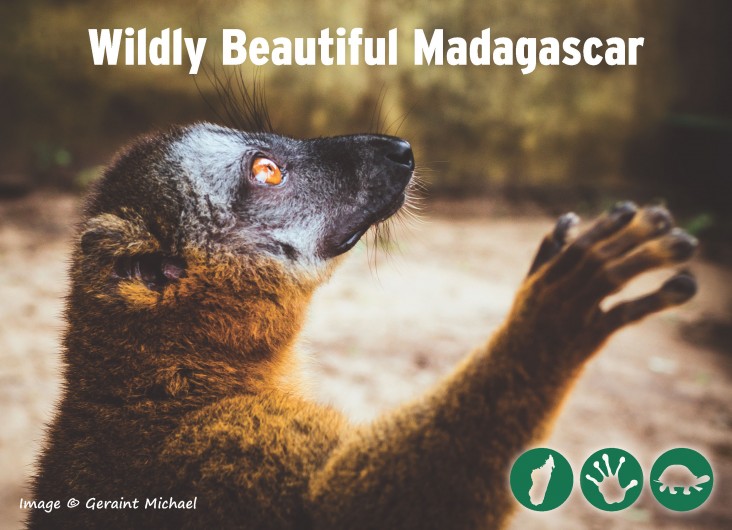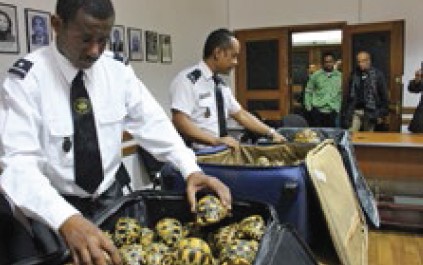Speeches Shim

What is wildlife trafficking?
Wildlife trafficking — poaching and illegal trade in wildlife and wildlife products — is one of the largest black markets in the world, measuring billions of dollars a year. It threatens the survival of iconic species as well as the security of nations and regions, economic development, and environmental health. Poachers and traffickers are often linked to international criminal networks that take advantage of poorly funded law enforcement, porous borders, weak civil society, and corrupt officials. These networks are violent and sophisticated, operating without concern for the harm they inflict on local communities, or the dangerous groups financed by the sale of wildlife products.
In Madagascar, the species most threatened by trafficking are:
 Precious Timbers* (e.g. Rosewood, Ebony, Palissandre) Illegally harvested and exported for production of high-value products like furniture and musical instruments.
Precious Timbers* (e.g. Rosewood, Ebony, Palissandre) Illegally harvested and exported for production of high-value products like furniture and musical instruments.
 Reptiles (e.g. Tortoises, Turtles, Chameleons, Geckos, and Snakes) Illegally collected for the exotic pet and medicine trade.
Reptiles (e.g. Tortoises, Turtles, Chameleons, Geckos, and Snakes) Illegally collected for the exotic pet and medicine trade.
 Lemurs (All Varieties) Poached for bushmeat and captured for the illegal pet trade.
Lemurs (All Varieties) Poached for bushmeat and captured for the illegal pet trade.
 Marine Life (e.g. Seahorses, Exotic Fish) Illegally harvested for food as well as the exotic pet and medicine trade.
Marine Life (e.g. Seahorses, Exotic Fish) Illegally harvested for food as well as the exotic pet and medicine trade.
 Birds (e.g. Parrots and Other Exotic Birds) Illegally collected for the exotic pet trade.
Birds (e.g. Parrots and Other Exotic Birds) Illegally collected for the exotic pet trade.
* USAID usually defines wildlife as wild animals, but illegal logging and associated trade in precious timber is known to facilitate wildlife crime and involves many of the same drivers: poverty, weak governance, and corruption.
Why does wildlife trafficking matter to USAID?

Wildlife trafficking is an international development issue because it undermines security, rule of law, and our efforts to end extreme poverty. Wildlife traffickers are normally part of larger criminal networks that are involved in trafficking of drugs, arms, and people. Therefore, wildlife trafficking contributes to the destabilization of communities where our beneficiaries and partners across all development sectors reside and can reduce or negate the impact of our health, food security, water and sanitation, and other programs. Billions of people around the world rely on forests, wildlife, and fisheries for their livelihoods. The loss of iconic wildlife and security due to the presence of violent elements linked to trafficking reduce prospects for sustainable development, including nature-based tourism and sustainable fisheries.
Protecting wildlife from poaching and illegal trafficking helps secure our global heritage and fights against the criminal networks that exploit humans and nature and thereby threaten national security and rule of law.
What is USAID Madagascar doing to combat wildlife trafficking?
SCAPES
The previous USAID/Madagascar environment project entitled Preserving Madagascar’s Natural Resources, which launched in 2013 and closed at the end of 2016, had a strong anti-wildlife trafficking component. This project brought together four international non-governmental organizations - World Wildlife Fund (WWF), Wildlife Conservation Society (WCS), Conservation International (CI), and TRAFFIC - to collaborate with local civil society organizations and the Government of Madagascar to address wildlife trafficking in and around the humid forests in the northeastern part of the country.
Known locally as SCAPES, for the global umbrella program Sustainable Conservation Approaches in Priority Ecosystems, activities were focused on addressing the trafficking of precious woods and reptiles, as well as training key actors to monitor, raise awareness of, and combat timber and wildlife trafficking at the landscape, regional, and national levels. This process engaged diverse members of society, from community-based organizations to timber traders, journalists, rangers, law enforcement authorities, courts, and government ministries.
Through the work of this activity, training was provided on enhanced identification of timber and reptile species; development of legal frameworks to improve management and reduce illegal wildlife trafficking; and skill development for Civil Society Organizations (CSOs) and investigative journalists in improved reporting on illegal practices. As a result of USAID’s support under SCAPES, a new National Coalition for Environmental Advocacy and three regional-level CSO coalitions (LAMPOGNO, COCAZ, TMTI) are now better able to identify, monitor and denounce wildlife crimes; community rangers and protected area staff are better trained in the use of law enforcement monitoring techniques using an interactive conservation software that enables better trade monitoring and protected area monitoring techniques to be adopted nationwide; and the Ministry of Environment, Ecology, and Forests and its development partners successfully prepared and adopted a Biodiversity Management Plan (BMP) for valuable timber species of the Dahlbergia and Diospyros genera.
The final assessment of the program can be found here [pdf 645kb].
END Wildlife Trafficking Act
USAID Madagascar along with all of the U.S. Government agencies present in or providing support to Madagascar (e.g., Departments of State and Defense, U.S. Fish and Wildlife Service, and others) are working together to formulate a comprehensive assessment of the current status of wildlife trafficking in Madagascar as mandated by the Eliminate, Neutralize, and Disrupt Wildlife Trafficking Act of 2016 (P.L.114-231). This assessment will help in the formulation and implementation of a national strategy for combating wildlife crime. Specifically, the END Wildlife Trafficking (END) Act seeks to (1) strengthen enforcement; (2) reduce demand for illegally traded wildlife; and, (3) build international cooperation and commitment.
Conservation and Communities Project
Building on the lessons learned from SCAPES, USAID Madagascar’s current environment project, the Conservation and Communities Project (CCP), supports the END Wildlife Trafficking Act national strategy as well as the Presidential Task Force on Combating Illegal, Unreported, and Unregulated (IUU) Fishing and Seafood Fraud (see details).
We raise awareness of these issues through our social media presence in Madagascar (Facebook and Twitter) as well as stand-alone awareness and demand-reduction campaigns like Wildly Beautiful, a print campaign of brochures, posters and postcards produced in partnership with the U.S. Department of State, three Government of Madagascar Ministries, and eight local development partners. These products target visitors to Madagascar as well as local communities living in and around potential wildlife extraction areas.
In addition, USAID Madagascar is a member of the Technical and Financial Partners Group of Madagascar’s Ministry of Environment, Ecology, and Forests (MEEF), which meets regularly to discuss priorities and how to match donor support to needs and national strategies in the sector. We are also active members of the Environmental Donors Group, an informal group of bilateral and multilateral donors working with various ministries on biodiversity, combating wildlife trafficking, climate change, land tenure, and related concerns.
Finally, we provide capacity-building opportunities to officials of the Government of Madagascar and local law-enforcement bodies by facilitating their participation in trainings offered by other U.S. Government agencies. And we support the leaders of community-based and non-governmental organizations working on wildlife trafficking through sponsored trainings, technical assistance, and small grants through the CCP.
Related Items
USAID Madagascar Wildly Beautiful campaign: Brochure [pdf, 1mb], Posters [pdf, 768kb], and Postcards [pdf, 247 kb]

The U.S. Embassy in Madagascar, USAID Madagascar, and the Madagascar Ministry of Tourism announce their “The Natural Beauty of Madagascar” postcard photography contest

USAID funded, TRAFFIC assessment of timber harvesting in Madagascar
Madagascar’s precious timber, represented by the genera of Dalbergia (rosewood and palisander) and Diospyros (ebony), are species of hardwood that have become much sought after in the last few decades for the manufacture of musical instruments in Europe and the US and for the manufacture of furniture in Asia. Starting in late 2008 and early 2009, the moist forests, home to the greatest wealth in species of precious timber have been subject to unprecedented high levels of logging, with hundreds of thousands of trees cut down in protected areas despite their protected status.

Paradise Lost? Lessons from 25 years of environment programs in Madagascar
The U.S.Agency for International Development (USAID) opened its Madagascar Mission in 1984 and rapidly became one of the principal actors in developing and implementing the three Environmental Programs (EPs) that operationalized the 1990 National Environmental Action Plan (NEAP).This retrospective is written 25 years later (with the Environmental Program suspended due to the 2009 coup d’état) to take stock of where we have come in efforts to save Madagascar’s threatened natural resources and to set the stage for discussions regarding future program directions.The paper focuses specifically on USAID’s environmental programs, while recognizing that USAID interventions took place in a context that involved many different partners. [PDF, 3MB] | Executive Summary [PDF, 187kB]


Comment
Make a general inquiry or suggest an improvement.